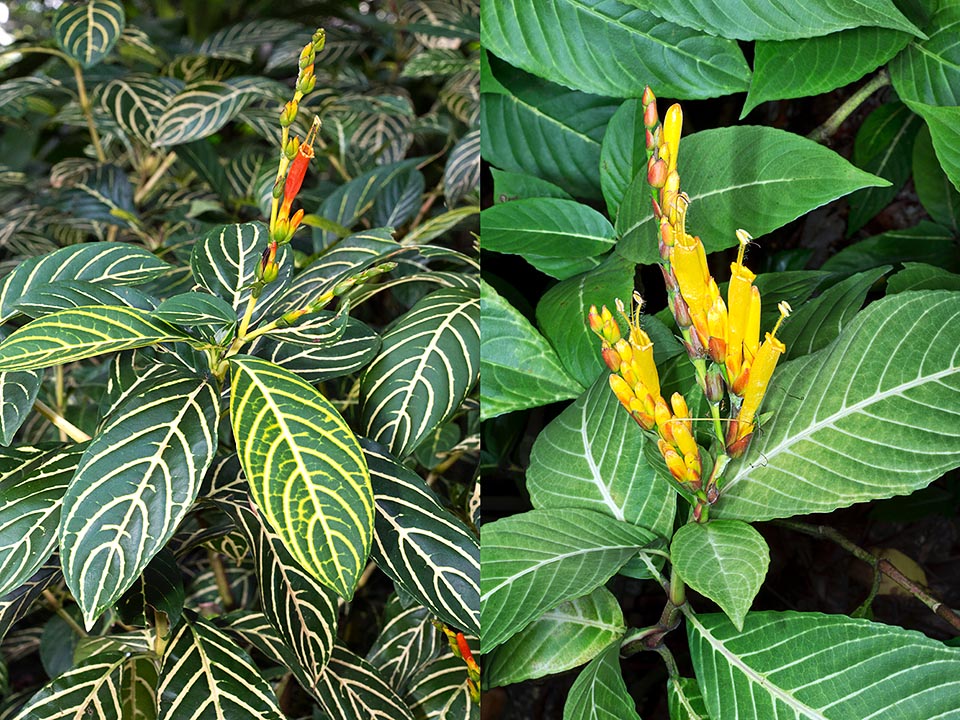Family : Acanthaceae

Text © Pietro Puccio

English translation by Mario Beltramini
The species is native to Colombia where it grows in the underwood of the pluvial forests at low altitudes. The genus was honoured in 1794 to the Spanish botanist José Sanchez; the name of the species is the Latin adjective “speciosus, a, um” = beautiful.
Common names: Colombian flag, fire fingers, large-bract sanchezia, shrubby whitevein (English); sanchézie (French); sanquésia (Portuguese-Brazil); cachimbo amarillo (Spanish).
The Sanchezia speciosa Leonard (1926) is an evergreen ramified semi-woody shrub, erect, up to about 2,5 m tall, with quadrangular stems of green or yellowish purple colour. The leaves, on a 0,5-2 cm long petiole winged at the base, are simple, opposite, oblong-elliptic brusquely pointed at the apex, of 10-25 cm of length and 4-8 cm of breadth, coriaceous, of intense glossy green colour with white or pale yellow nervations and waved crenate margins.
The inflorescences are 20-40 cm long erect terminal spikes, with yellow or pink quadrangular rachis, with 1-3 cm long internodes and persistent ovate red orange bracts, up to 4 cm long, subtending 3 or more unilateral hermaphroditic flowers. The single flowers present an about 2,2 cm long calyx with five 1,6 cm long and 0,5 cm broad lobes, tubular yellow or orange corolla, 4-5 cm long, with five 0,4-0,6 cm long twisted lobes, 2 fertile villous stamina exceeding the corolla by 1-1,5 cm, 2 filiform 2-2,5 cm long staminodes, and yellow filiform 5-6 cm long style with red stigma; the flowers are pollinated by the hummingbirds. The fruits are oblong capsules containing 6-8 circular, compressed seeds.

Native to Colombia, Sanchezia speciosa is a semi-woody shrub reaching 2,5 m of height. Ornamental foliage and unusual corollas © Giuseppe Mazza
Appreciated species especially for the particularly ornamental foliage, cultivable in the humid tropical and subtropical climate zones, as it does not stand temperatures close to 0 °C unless exceptional and for a very short period, with possible loss of the aerial part. It requires an exposition in full sun or filtered sunlight, in the shade the leaves tend to become uniformly green, and soils rich of organic substance, acidic or neutral, draining, maintained almost constantly humid. It can be utilized in parks and gardens as isolated specimen, soil cover or for borders, even mixed, with regular watering with preferably non-calcareous water and fertilizations with balanced products in spring-summer. It bears well the pruning for a more compact appearance.
It is well suited for growing in pot, thus to be sheltered during the coldest months where the climate does not allow its permanence in open air, for the decoration of greenhouses, verandas and also of interiors, choosing a particularly luminous position, such as a window looking south, utilizing an organic loam with addition of siliceous sand per a 30%. The watering must be regular in summer, more spaced in winter, allowing the substratum to partially dry up before watering again, with daily temperatures of 20-24 °C and lowest night ones not under the 16 °C, and high atmospheric humidity, 60-70%, in order to avoid the premature fall of the leaves. For increasing the humidity, place the pot on a tray with pebbles or expanded clay granules maintained constantly wet and frequently nebulise with water at ambient temperature and not calcareous, to avoid unaesthetic spots on the leaves. It is easily subject to mites (red spider mite) and scale insects, to be treated with specific products in case of serious infestation.
